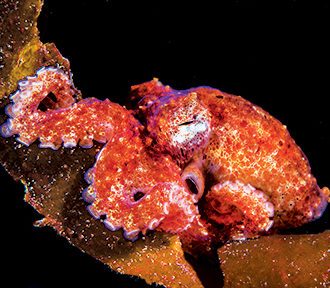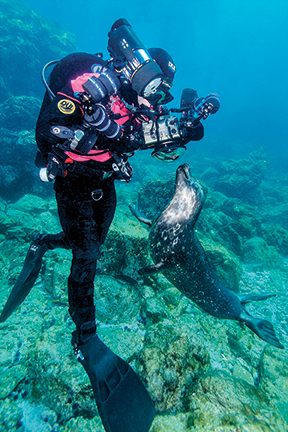An Upwelling of Abundance
WHEN I MOVED TO SAN DIEGO, CALIFORNIA, from New England in January 2007, I knew next to nothing about the area. As I made my way across the country, I considered my future — one that was hazy, although it seemed likely to involve fish tacos and a diminished need to say that I “loved the seasons.” I had an easier time envisioning the local diving: towering kelp forests and sharks everywhere.
The steel tanks packed into my trunk merrily clinked as I pulled into my tiny bungalow’s gravel driveway, and I grinned at the blue sky and the thermometer on my dashboard (70 glorious degrees!). “Seasons?” I thought to myself smugly, “Who needs ‘em?”
I’ve become somewhat less smug over the years, notably on days that it takes me 80 minutes to drive 10 miles or when my monthly mortgage bill arrives. Still, I have no regrets. My predictions weren’t quite accurate about the diving but in the best possible way: The opportunities are far more variable than I ever imagined.
San Diego certainly has kelp forests, and you can reliably view some shark species during certain seasons, but these features just scratch the surface. Submarine canyons immediately offshore plummet to depths of more than 600 feet, the proximity providing an incredible array of marine life. Upwellings deliver an ever-changing, colorful array of pelagic invertebrates. Baitballs and mola molas aren’t particularly rare. Dolphins and migrating whales are downright common topside sights.
In short, lesson No. 1 on San Diego diving is that divers really, truly can see almost anything at any time — it’s not just a cliché.

Muck and More
Like most local divers, my first foray into San Diego diving was at La Jolla Shores, part of the La Jolla Underwater Park. Local divers of all skill levels love this beach site, and the parking lot was packed with divers when I arrived. At first I couldn’t understand the appeal: a surf entry followed by a marathon surface swim, only to be greeted by a view of … sand. The only kelp consisted of mats of kelp detritus.
I descended toward the stalks, feeling deeply misled until I noticed movement on top of one of the leaves — a little octopus was working its way across the tangled mess. The closer I got to the bottom, the higher the critter count became. Nudibranchs, blennies, pipefish, and even a tiny horn shark inhabited this debris field. Not 10 minutes in, and I was already hooked.
The Shores remains one of my favorite sites anywhere; you can have spectacular dives here without going below 60 feet. Although this is inarguably one of the best muck sites in Southern California, it isn’t all about small stuff. Fortunate divers may witness a market squid mating run or even spot a migrating gray whale (this happens every few years), and summertime reliably brings schools of skittish but gorgeous leopard sharks.
A bit farther south in the underwater park, La Jolla Cove provides the more stereotypical California vista of orange Garibaldis and crimson California sheephead wrasses weaving through a pretty kelp forest.


Get Lost in the Forest
Multiple kelp forests are off the San Diego coast, but perhaps the area most divers frequent, aside from La Jolla Cove, is the Point Loma kelp beds. Most of the popular reefs here top out at 50 to 80 feet, with the kelp and its abundant commensal life providing plenty of vertical structure to keep you occupied during ascents and safety stops.
The water here is often cold (a few degrees more so than other local sites) and quite nutrient-rich, but that helps pump up the marine life. The rocky reefs are lushly layered with colorful invertebrate life, including Corynactis anemones, bryozoans, sponges, and gorgonians. The small stuff is abundant here, and divers can expect to see fringehead blennies and a huge variety of nudibranchs — I’ve counted 20 different species on a single dive.
Bigger creatures also frequent kelp sites, though they are a bit less predictable: The sevengill shark is a local favorite with its muppet-like face, leisurely swimming style, and tendency to approach divers closely (sometimes unnervingly so).
The Biggest Bash in Town
Divers of all experience levels adore Islas Coronados, a cluster of Mexican islands off the coast of Baja Mexico, located a mere 7 miles south of the U.S. border. Mexico might sound like a major excursion, but it’s an easy day trip from San Diego — albeit one that requires a passport. Believe me, this thronging destination is worth toting along an extra document or two.
You’ll be aware of the festive goings-on long before you see the revelers. Approaching Lobster Shack, a popular dive site on the northernmost island, the barking (also the smell, but primarily the barking) is impossible to ignore. Once you get closer, you’ll spot the sea lions in the water.


If you’re lucky enough to be there in the fall, a few months after peak mating season, dozens of juvenile pinnipeds will form a churning, jumping mass of boisterousness. Once you enter the water, any attempts at decorum are doomed to fail: These playful animals will be all over you, reducing you to little more than a plaything. Everything — including lights, fins, hood, and camera — will require an investigation.
You can also spot other pinniped species, such as harbor seals and — very rarely — elephant seals, at the shallow sites of the Coronados, but both species are usually more standoffish with divers.
I’d be remiss not to mention that these islands boast several sites in less than 50 feet (perfect for divers of all experience levels) that provide a complement of other marine life, including moray eels, nudibranchs, fringehead blennies, and Garibaldis. The sea lions are the main attraction, however, and they know it; if you dare focus your interest on something else, they will likely pester you mercilessly until you pay them proper attention.
Wrecks to Riches
Metal enthusiasts are utterly indulged in San Diego, where the nutrient-dense water encourages the growth of stunning invertebrate coverage on submerged wreckage. Wreck Alley, renowned for its collection of purpose-sunk wrecks, is a favorite.
The amazing HMCS Yukon, a 366-foot Canadian destroyer in 70 to 105 feet of water, is the site’s star. The Yukon went down in rough seas in 2000, only hours before its intended reefing, and lies on its port side. That orientation can be disorienting, and the surge at this site can be fierce. Despite the steady deterioration of some of the superstructure, the Yukon has retained plenty of recognizable features, including the propeller, guns, and radar dish, all beautifully blanketed with Corynactis and sponges and inhabited by scorpionfish, cabezon, kelp bass, and schools of blacksmith.
Other wrecks in the area are similarly colorful but smaller sites at slightly shallower depths and are usually billed as the second or third dive sites of a multidive wreck charter. These wrecks include the Ruby E, a U.S. Coast Guard cutter-turned-drug-smuggling vessel, and the El Rey, a kelp harvester.


A nearby structure, the NOSC (Naval Ocean Systems Center) Tower, sank naturally during a strong storm and is located closer to the beach in 50 feet of water. Although it is little more than crisscrossed metal pilings, this less-visited site is also a standout dive when conditions are good.
For advanced and technical divers, another popular site is the wreck of the Hogan, a destroyer that was used for target practice and finally sank to a depth of 120 feet on the California–Mexico border. Although the structure is low-profile and fairly broken up (the most recognizable structures are the stern and boilers), the inhabitants here usually include wolf-eels and large lingcods.
You may anticipate that ascents from the wrecks are the most boring part of a San Diego dive day — there’s no sand or kelp to inspect and nothing to do but safely pass the time. But it’s important to remember that the dive isn’t over until you surface, and that’s extra true in San Diego.
During safety stops above the Yukon, I’ve watched huge black sea nettle jellyfish pulse by, been approached by a trio of Pacific white-sided dolphins, and had a pelagic stingray circle me repeatedly and so closely that I had to back up to photograph it with a fisheye lens.
Yes, lesson No. 1 on San Diego diving even includes your safety stop. Maybe it makes sense that we’re a tiny bit smug. AD

How to Dive It
Getting there:
Visibility in San Diego can vary widely from less than
10 feet to more than 70 feet.
Water temperatures at depth range from 48°F to 62°F year-round, with the coldest water in late spring. Midsummer through winter (July through December) usually sees the best overall conditions, with fall months providing the highest chance for calm seas combined with good visibility and warmer water temperatures. A drysuit or 7 mm wetsuit with a hooded vest is recommended year-round.
Other considerations:
San Diego offers sites that are appropriate for all skill levels, but divers needing more coldwater experience should strongly consider hiring a guide. For beach dives it’s additionally recommended that divers review basic principles for shore diving and surf entries before their dive day (see Advanced Diving in the Fourth Quarter 2021 Alert Diver) and consult with lifeguards regarding conditions before their dives. There are multiple local boat charter operators, but spaces can fill up early, especially during the summer and early fall, so divers should plan ahead if they want to boat dive.
© Alert Diver — Q3 2023